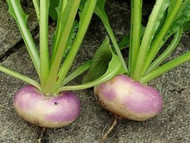How To Grow Turnip (White)
Milan Purple Top has distinctive flat-topped roots, white with purple crown. Quick maturing, useful in frames and under cloches.
They are a fast crop, being ready in just five to eight weeks from sowing to harvesting at the size of a golf ball or a little larger. As they grow on they become less tender and flavorsome so successional sowing every two weeks ensures a constant supply of young and sweet turnips.
Where to Grow
Because they are faster growing than swedes, they require a higher level of fertility. Ideally the soil should have been manured for a previous crop and the pH level should be around neutral. Like most brassicas they do not like an acid soil. A week or so before sowing provide 50 to 75 grams of general purpose fertiliser like fish, blood & bone for best results.
When to Grow
Sowing can start as early as late February under cloche and run through to August. Maincrop varieties that are sown in July and August require a larger spacing, 25cm, to allow the larger root to develop for harvesting in November and December.
Transplanting
With a dibber (Broom handle will do) make rows of 4-inch deep holes in the transplanting area at 10-15 cm apart. Allow 50cm between each of the plant rows.
Pop each transplant into the prepared hole, and don’t worry that you are planting them too deep. Plant the seedlings firmly, after which they should be well watered taking great care not to disturb the roots.
Crop Care
Turnips are a relatively trouble free crop, cultivation is mainly a matter of keeping them weed free and watering in dry periods to avoid woody texture and split skins. Because they are so fast growing, it is important to start thinning as soon as possible. If they are allowed to crowd, decent roots will not develop.
Pests and Diseases
Apart from clubroot, turnips can be troubled by the cabbage root fly. If this is a problem on your site, use horticultural fleece to keep the pest off until the crop is well established. They can suffer with flea beetle and powdery mildew, especially if overcrowded.
Harvesting
Loosen soil around the root then grab leaves and pull.
Storage:
Clean them, remove the skins and place on a tray, place the tray in the freezer for about an hour, then transfer into a freezer bag.
Use them from frozen in soups, stews or as a veg side dish.
